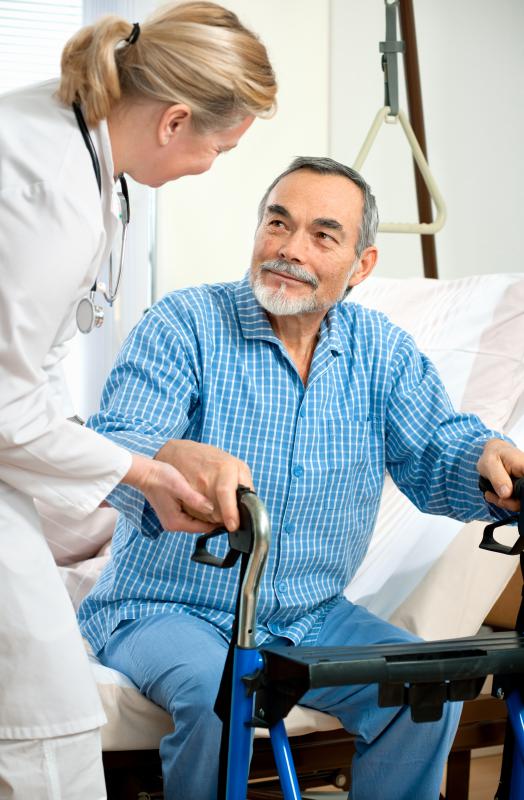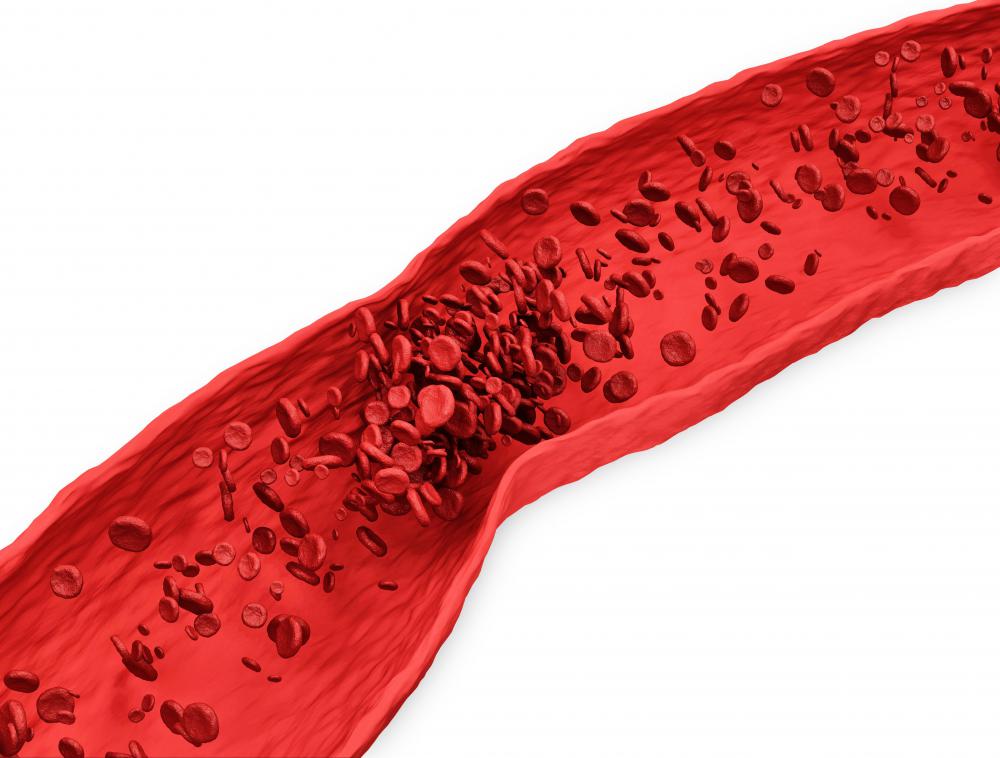At TheHealthBoard, we're committed to delivering accurate, trustworthy information. Our expert-authored content is rigorously fact-checked and sourced from credible authorities. Discover how we uphold the highest standards in providing you with reliable knowledge.
What is a Saddle Embolism?
A saddle embolism is a clot that blocks both sides of an arterial branch. The classic example is a saddle pulmonary embolism that appears at the split of the pulmonary artery, blocking blood flow to the lungs by effectively plugging both branches of the pulmonary artery. This type of clot can be a life threatening medical issue, depending on where in the body it is located.
In the case of a saddle pulmonary embolism, the blood clot commonly leads to death before it is even diagnosed, and it is a common finding during necropsy of pulmonary embolism victims. Most commonly, the clot originates in the legs. Sometimes, a saddle embolism can be caused by a clot of fat or another material. It can lead to death very rapidly because the blockage of the blood flow to the lungs makes the patient highly unstable and if the embolus moves, it can completely cut off the supply of blood, leading to sudden death.

This type of embolism can be caught before it causes death if a patient experiences a gradual onset of symptoms and goes to a hospital for treatment. The clot will be visible on a medical imaging study and immediate surgical treatment can be offered to clear it. Because the risks of pulmonary emboli are very serious, people with clotting disorders are given medications and carefully monitored for any signs of complications. Likewise, people at risk for clots, such as individuals sitting on long flights, are encouraged to take steps to avoid clotting, such as periodically exercising to circulate the blood in the legs or wearing support stockings to reduce blood pooling.

Saddle emboli can strike in locations other than the pulmonary artery. There are a number of sites in the body where a large artery splits into two or more branches to bring a supply of blood to another area of the body. At any one of these points, an embolus can become lodged. The clot cannot successfully clear because the branches are much narrower, and it can snag in the branch. The blood flow may be partially obstructed, moving sluggishly past the clot, or it can become completely blocked.
Treatments include catheterization procedures to pull the clot out, surgery, and medications to break up clots. Care providers must act quickly to identify and remove or break up clots to reduce the risk of severe complications for the patient.
AS FEATURED ON:
AS FEATURED ON:














Discussion Comments
I was diagnosed with a saddle PE about 3 years ago. Along with the saddle PE, both lungs were filled with clots and had a DVT in my right leg. Between the onset and diagnosis, it was almost a month.
I rolled my right ankle and it took time to find out it broke when it rolled. It was a walking break. I complained to Urgent Care about a pain behind the right knee. I was also sick with something else at the time. So they kind of ignored that symptom. Then I had a horrible pain in the middle of the night in the front of my right shoulder. The family doctor said it was acid reflux. My breathing got worse and worse. Finally, I tried to work one day and almost passed out just walking into the building. I drove myself to the ER.
I was transferred from my local hospital to another one 30 miles away. I had surgery to run cath wires up to my lungs. They hooked those to ECOS machines. The machines vibrated the wire at a high rate of speed to help dissolve the clots. I was in the ICU for 2 days and then in a regular room for 4 more. Afterward, I found out that I had Factor V Leiden mutation. I also found out that I had homocysteinuria (high homocystein levels in my blood which can also cause clots.) My hematologist said that I had the trifecta. I broke my ankle, genetic clotting factor, was on birth control pills for another medical issue. I was told that I was lucky to be alive. I was told that I was about 24 hours from death. I don't know about others who have had this, but my breathing tests haven't gone back to normal since the PE. My allergy breathing tests were always in the upper 90's pre-PE, after PE they have been in low to mid 80's, still three years later.
If you have had a clot or clots, no matter your age, and they can't tell you why you developed one (smoking, obesity, etc), then you should find a hematologist to have your blood checked. My husband was diagnosed with a Factor II (F2) G20210A mutation - it's a genetically inherited risk for thrombosis associated with increased plasma prothrombin (you have a much higher risk of throwing clots). Only way it was discovered was going to a blood specialist doctor to have your blood tested.
I too just went through this. My first symptoms were the heart attack,then the TIA. Only after great persistence did they finally do the CT scan and found it. Every doc who came in said it was fatal, but after a week, they sent me home on blood thinners (surgery wasn't worth the risk). I got no instructions or specific limitations! They just told me if I had more symptoms I should call 911 immediately since it could still be fatal! Wish they had given more instructions and done a risk evaluation.
It is called a saddle because it takes on the shape of a saddle after branching between two arteries.
I was recently diagnosed with a saddle embolism. The doctor in the ER said I must have a lucky horseshoe up my bleep, because I came in to the ER when I did.
I spent five days in the hospital and was released with Lovanox injections and coumadin. What I need to know is, am I going to keel over dead even with these meds, or can I just resume my normal life which does include lifting a 60 pound handicapped little boy several times a day?
I'm 22 years old, and I was diagnosed with a saddle embolism in my lung in April. The doctors told me that they have no idea how I am alive. This blocked both sides. My right side was close to 95 percent blocked off and my left close to 75 percent. The doctors were amazed how I was even walking around the Mayo clinic for my appointment.
My surgeon told me that If I refused the surgery that my heart would go into cardiac arrest, or the clot would kill me. In July, I had open heart surgery to remove the clot, and it was a long process, but they were able to remove everything. I will be on "thinners" now for the rest of my life, and they still have no reasons why I developed one.
Now it's been almost four months since the surgery, and I feel like the shortness of breath is coming back.
I just spent five days in the hospital with one of these. The way it was explained to me, the clot lies across the split of the pulmonary artery in such a way that it resembles the look of a saddle. Hence, the name.
A saddle embolism, according to Wikipedia, is also called a straddling embolism because it straddles multiple branches. Their article is much shorter than this one and it doesn't say why it's called a saddle embolism. But I'm guessing it's because it lays over the branches the way a saddle would lay over the back of a horse.
Medical terms are so vivid! "Saddle" doesn't sound like it would describe something so serious, when saddle pulmonary emboli are usually fatal. My favorite peculiar name is "Scottish terrier sign," when part of your spine looks like a Scotty dog under X-ray and the doc looks to see whether the dog appears to be wearing a a collar.
Why such a frivolous name for something so serious? Why's it called a saddle embolism?
Post your comments